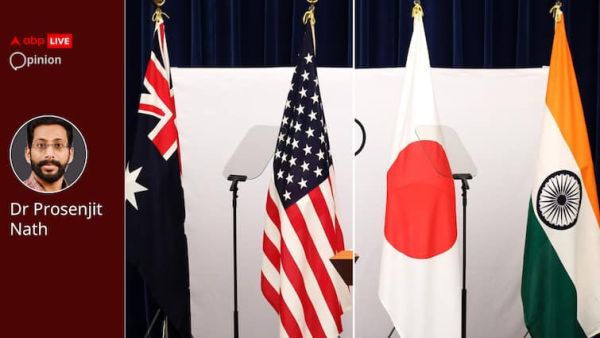
In July 2025, the Quad nations — India, the United States, Japan, and Australia — took a significant step toward rewriting the geopolitics of global supply chains. By launching a new initiative to secure and diversify the supply of critical minerals, the four democracies signalled their intent to reduce dependence on a resource ecosystem long dominated by China. This move is as much about economic self-preservation as it is about strategic autonomy. From electric vehicles to solar panels, from smartphones to precision missiles, the future runs on critical minerals. Right now, that future is largely in Beijing's hands.
This initiative could not have come at a more crucial time. In April 2025, China imposed new export restrictions on several critical minerals, tightening the noose on countries that rely on its refining capabilities. India, in particular, has borne the brunt of this move: export licenses for Indian firms have been withheld, tech supply chains are stalling, and crucial semiconductor plans are now delayed. This isn't trade policy. It's economic coercion disguised as regulation. The message from Beijing clear: "Defy us at your own peril."
China's dominance is not accidental. For over four decades, it has pursued a deliberate, state-backed strategy to secure its mineral supremacy. It invested early in African and Latin American mines, dominated midstream processing, built vast refining capacity, and trained a domestic workforce to support the industry. Today, China refines roughly 90% of rare earths and processes 70% of critical minerals worldwide. Its control over neodymium magnets, which are essential for EVs and wind turbines, is nearly absolute.
What the Quad is attempting now is not a simple decoupling. It is a herculean effort to build a parallel industrial ecosystem capable of matching China's efficiency, cost-effectiveness, and reach. And herein lies the rub. The initiative is noble, but the mountain ahead is steep and riddled with strategic, economic, and logistical challenges.
The Quad's plan envisions a collaborative framework. Australia, with its rich reserves of lithium and rare earths, can lead mining. India, eager to expand its green tech sector, can develop processing plants. Japan and the U.S., with their financial muscle and technological edge, can handle high-end refining, recycling, and innovation. There's also a pivot toward Africa, home to nearly a third of the world's mineral reserves. The goal: bypass Chinese intermediaries and build resilient, transparent supply lines that serve mutual national interests.
On paper, the model is compelling. Picture this: cobalt mined in the Congo is processed in an Indian plant built with Japanese and American capital and then integrated into batteries for EVs assembled in the U.S. or Australia. Or consider a plant in Gujarat turning Australian lithium into batteries for Tesla, free from Chinese interference. The possibilities are tantalising, but they require more than vision. They need hard money, steady policy, and global coordination.
India has already made early moves. NMDC, its largest state-owned miner, has opened an overseas office in Dubai to track developments in the mineral sectors of Australia and Africa. Explorations are underway for acquisition deals that would anchor India in the global mineral map. Similarly, discussions around creating joint processing hubs in Latin America or Africa could open new frontiers in the supply chain. These efforts, however, must be scaled significantly and fast.
The Quad also seeks to address a critical blind spot: recycling. E-waste recycling and mineral recovery from used electronics and batteries is a low-hanging fruit, especially for countries like Japan and the U.S., which have mature tech industries. Not only does this reduce dependency on raw ore, but it also aligns with sustainability goals and lessens environmental damage.
But the Quad faces three key challenges.
First, scale and cost. China's refining capabilities are vast, efficient, and heavily subsidised. Quad-backed projects will struggle to match Chinese pricing unless governments are willing to underwrite losses for strategic gains.
Second, coordination and clarity. The initiative still lacks specifics. Who leads? What is the governance structure? What financial commitments have been made? Right now, the plan feels more declarative than directive.
Third, geopolitical friction. Even within the Quad, unresolved trade tensions exist. India has had long-standing complaints about U.S. visa restrictions on tech workers. Japan is wary of militarising trade policy. And recent US tariffs on Asian goods have irked allies. Unity of purpose must be backed by unity in practice.
Then there's the ticking clock. Building a mine takes years. Setting up refining facilities can take a decade. China already has the infrastructure and institutional memory. It's not sitting idle; it is doubling down on its investments, strengthening its grip on African resources, and positioning itself as a global green-tech leader.
Still, despite these headwinds, the Quad's initiative is a spark of strategic realism in a world increasingly defined by resource geopolitics. For too long, democracies have allowed market logic and short-term gains to dictate supply chains. That age is over. The pandemic, the Russia-Ukraine war, and the intensifying U.S.-China rivalry have made one truth abundantly clear: economic security is national security.
To succeed, the Quad must do three things:
- Commit real capital from sovereign wealth funds, public-private partnerships, and development banks to fund mining, refining, and R&D.
- Develop unified regulatory frameworks that enable swift approvals, labour protections, and environmental safeguards, without bureaucratic delays.
- Forge global partnerships, especially with mineral-rich but underdeveloped regions in Africa, Latin America, and Southeast Asia. These alliances must be built on transparency, mutual benefit, and ethical sourcing, unlike China's exploitative models.
The age of fossil fuels reshaped geopolitics in the 20th century. The age of critical minerals will do the same in the 21st century. Whoever controls lithium, cobalt, graphite, and rare earths will control not just the energy transition but also the future of warfare, communication, and innovation.
The Quad has lit the match. Now, it must build the fire. Only then can the world shift from dependence on monopoly to a model of mutual resilience and trust. China has had a 40-year head start, but the next decade will decide who controls the arteries of the global economy. The stakes are nothing less than sovereignty itself.
(The writer is a technocrat, political analyst, and author)
[Disclaimer: The opinions, beliefs, and views expressed by the various authors and forum participants on this website are personal and do not reflect the opinions, beliefs, and views of ABP Network Pvt. Ltd.]
-
Toxic Metals In Breast Milk Linked To Infant Stunting, Alarming Study From Guatemala Finds
-
Pandya Store Actress Pallavi Rao Announces Divorce From Husband Suraj Rao After 22 Years Of Marriage: 'Had Compatibility Issues'

-
First Love Again K-Drama Fame Kang Seo-Ha Dies At 31 Due To Stomach Cancer

-
Singer makes Rs 25L in hours and spends Rs 20K on just one meal!

-
Dipika Kakar Shares Health Update, Says Still Too Weak To Hold Son Ruhaan
